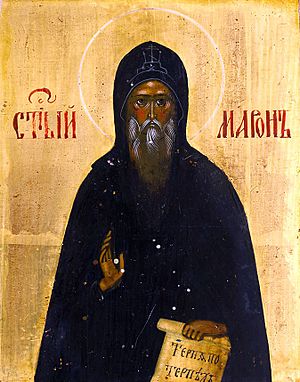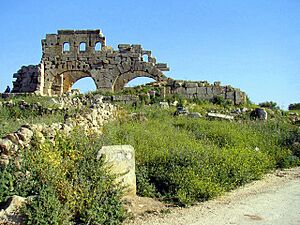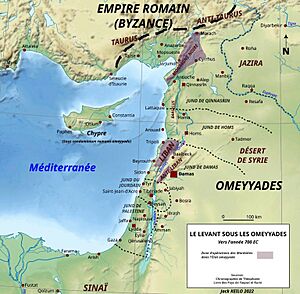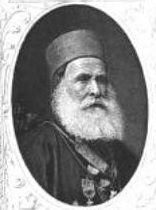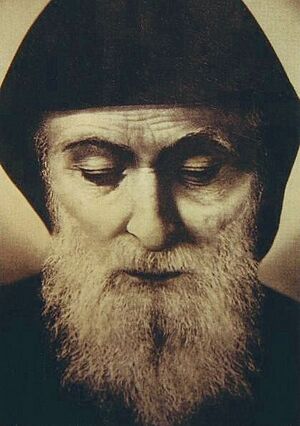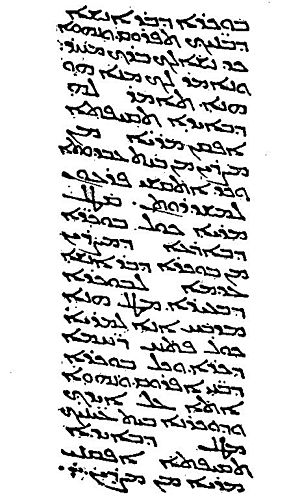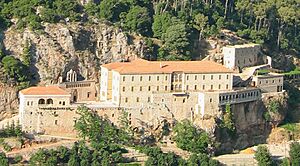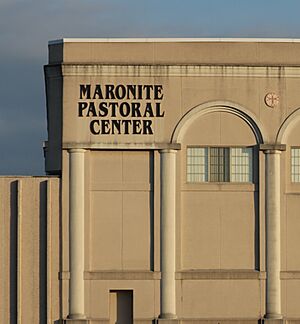Maronite Church facts for kids
Quick facts for kids Antiochene Syriac Maronite Church |
|
|---|---|
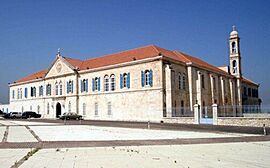
Seat of the patriarchate in Bkerké, Lebanon
|
|
| Type | Particular church (sui iuris) |
| Classification | Christian |
| Orientation |
|
| Scripture | Peshitta |
| Theology | Catholic theology |
| Polity | Episcopal |
| Governance | Holy Synod of the Maronite Church |
| Pope | Francis |
| Patriarch | Bechara Boutros al-Rahi |
| Region | Lebanon (approximately one third), Syria, Israel, Cyprus, Jordan, Palestine and diaspora |
| Headquarters | Bkerké, Lebanon |
| Founder | Maron; John Maron |
| Origin | 410 AD Monastery of Saint Maron, Phoenicia, Roman Empire |
| Members | 3,498,707 |
The Maronite Church is a special Christian church that is part of the larger Catholic Church. It is called an "Eastern Catholic" church because it follows ancient traditions and ways of worship from the Middle East. The Maronite Church is in "full communion" with the pope in Rome, meaning they share the same beliefs and are united under his leadership.
This church has its own rules and leaders, which is why it's called sui iuris (meaning "of its own right"). The main leader of the Maronite Church is called the Patriarch. Since March 2011, this leader has been Bechara Boutros al-Rahi. The main office of the Patriarch is in Bkerké, Lebanon. The Maronite Church is also known as the Antiochene Syriac Maronite Church and is part of Syriac Christianity, which means it has roots in the early Christian communities that spoke Aramaic (Syriac).
Contents
History
The Maronite Church developed over several centuries, starting from the 4th century. It began as a movement inspired by Maron, a holy man from the Taurus Mountains. He is considered the church's patron saint.
Early Beginnings
The second period of the church's development started with the building of the Monastery of Saint Maroun on the Orontes River. This monastery was built after an important meeting called the Council of Chalcedon to support its teachings. Old records describe it as a very large monastery with over 300 small hermitages (places where monks lived alone) around it. After the year 518, this monastery managed many church areas in the region.
The third period began after the Islamic conquest of the area. During this time, there was no official leader for a while. Around 685 AD, the bishops from the Saint Maron Monastery chose John Maron as their Patriarch. This was an important step for the Maronite Church. Other important historical places for the Maronites include Kfarhay, Yanouh, Mayfouq, and the Qadisha Valley.
Today, the Maronite people are a distinct group, especially in Lebanon. Smaller groups of Maronites also live in Syria, Cyprus, Israel, Palestine, and Jordan. Many Maronites have moved to other countries since the 1800s. About two-thirds of the church's 3.5 million members (as of 2017) now live outside the Middle East, as part of the worldwide Lebanese diaspora.
The Founder, Saint Maron
Maron was a monk who lived in the 4th century. He was a friend of John Chrysostom, another famous Christian leader. Maron decided to live a simple, spiritual life in the Orontes River area in what is now Syria. He followed the ways of other desert monks like Anthony the Great. Many people followed him and also lived a monastic life.
The Maronite Church believes that Saint Maron started the spiritual and monastic movement that grew into their church. Maronite Christianity has had a big impact on Lebanon, and also on Syria, Jordan, and Palestine. Saint Maron spent his life on a mountain in Syria, which is thought to be in the Taurus Mountains in modern-day Turkey. This area became the birthplace of the Maronite movement.
After Maron died in 410 AD, his followers built the Beth-Maron monastery at Apamea. This monastery became the center of the Maronite Church. In 452, the Byzantine emperor Marcian helped expand the monastery.
The Maronite movement reached Lebanon when Saint Maron's first student, Abraham of Cyrrhus, traveled there. He is known as the "Apostle of Lebanon" because he helped convert non-Christians by teaching them about Saint Maron.
Challenges and Beliefs
The Maronites strongly supported the decisions made at the Council of Chalcedon in 451. This led to disagreements in Syria between those who supported Chalcedon and those who did not, like the Jacobites. A letter from 517, supposedly from Maronites to Pope Hormisdas, claims that Jacobites killed 350 Maronite monks and burned their monastery. However, whether this event truly happened is still debated by historians.
Another letter from Pope Hormisdas (514–523) in 518 is said to be a response, but it doesn't specifically mention the massacre or the monastery. It only invites all of Syria to unite with Rome. Maronite representatives attended church meetings in Constantinople in 536 and 553.
A civil war and attacks by the Persian king Khosrow II caused problems in Syria. In 609, the Patriarch of Antioch, Anastasius II, was killed. This left the Maronites without a leader for a long time.
After the war, Emperor Heraclius tried to unite the Christian churches in the East by introducing a new idea called Monothelitism. This idea said that Christ had two natures (divine and human) but only one will. It was meant to be a compromise between different Christian groups. However, Monothelitism did not solve the disagreements and was later declared a heresy (a wrong belief) at the Sixth Ecumenical Council in 680–681. This council condemned some leaders but did not directly mention the Maronites.
Some historical sources from Greece and Arab countries suggest that the Maronites at first accepted Monothelitism and later changed their minds during the Crusades. However, the Maronite Church strongly denies that they ever believed in Monothelitism or broke away from Rome. This topic is still discussed by historians.
The First Maronite Patriarch
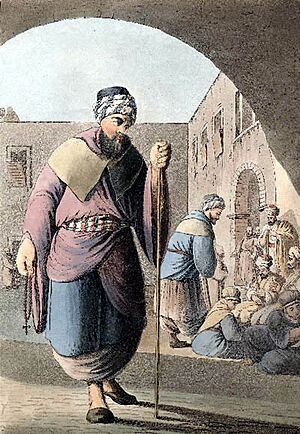
After the Patriarch of Antioch, Anastasius II, died in 609, leaders in Constantinople started appointing temporary patriarchs. In 685, the Maronites chose Bishop John Maron of Batroun to be their Patriarch of Antioch and all the East.
Around 687, the Byzantine emperor Justinian II made a deal with the Arab ruler Abd al-Malik ibn Marwan. As part of this deal, 12,000 Christian Maronites were moved from Lebanon to Armenia. They were then made to serve in the Byzantine navy.
John Maron settled in the remote Qadisha Valley in Lebanon. In 694, Justinian sent soldiers to try and capture the Patriarch, but they failed. John Maron died in 707 at the Monastery of St. Maron in Lebanon. Around 749, the Maronite community in the Lebanon mountains built the Mar-Mama church at Ehden. Meanwhile, the Beth-Maron monastery struggled to survive, caught between the Byzantines and the Arabs.
Under Islamic Rule
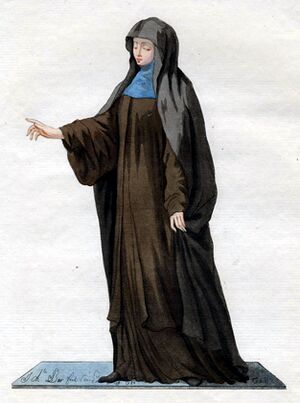
After the Muslim conquest of Syria (634–638), the Maronites came under Arab rule. More Maronites moved to Lebanon, especially during the time of the Abbasid ruler al-Ma'mun (813–833).
From 1289 to 1291, Egyptian Mamluk troops attacked Mount Lebanon to stop disagreements. They destroyed forts and monasteries.
The Crusades and Rome
For about 400 years after the Muslim conquests, not much was heard from the Maronites. They lived safely in their mountain strongholds. In the late 11th century, during the Great Crusade (1096–1099), Raymond of Toulouse met the Maronites in the mountains near Tripoli, Lebanon. This meeting helped reconnect the Maronites with European Christianity.
The Maronites helped the crusaders and confirmed their loyalty to the Holy See (the Pope) in Rome in 1182. To celebrate this reunion, Maronite Patriarch Youseff Al Jirjisi received a special crown and staff from Pope Paschal II in 1100 AD. In 1131, Pope Innocent II sent letters to Maronite Patriarch Gregorios Al-Halati, recognizing the authority of the Patriarchate of Antioch. Patriarch Jeremias II Al-Amshitti (1199–1230) was the first Maronite Patriarch to visit Rome when he attended the Fourth Council of the Lateran in 1215. The Patriarchate of Antioch was also represented at the Council of Ferrara-Florence in 1438.
During the Mamluk rule over Lebanon, Maronites faced hardship. Many were killed, and others moved to Cyprus. Maronite Patriarch Gabriel II was burned alive in 1367 by the Mamluks. After an attack on the patriarch's home, the patriarchal seat was moved to the Monastery of Our Lady of Qannubin, where it stayed for centuries.
Under Ottoman Rule
In the Ottoman Empire, religious groups like the Maronites usually dealt with local leaders. Maronites, as non-Muslims, had to pay a special tax called jizya. However, monks and clergy were sometimes excused because they were considered poor.
Fakhr-al-Din II (1572–1635) was a Druze prince and a leader in Mount Lebanon. A Maronite leader named Abū Nādir al-Khāzin was one of his main supporters. The Maronites benefited from this relationship, gaining political protection and local allies against direct Ottoman rule. In 1649, Patriarch Yuhanna al-Sufrari placed the Maronites under French protection, and France opened a consulate in Beirut.
The Khāzin family grew in power. In 1662, Abū Nawfal al-Khāzin became the French consul. The Church benefited from the Khāzins' protection, but the Khāzins also interfered in church matters, especially in choosing church leaders.
Bachir Chehab II was the first and last Maronite ruler of the Emirate of Mount Lebanon.
The relationship between the Druze and Christians has generally been peaceful, with good relations between the two groups throughout history, except for a few times, like the 1860 Mount Lebanon civil war.
Maronite Catholics and Druze people together helped create modern Lebanon in the early 1700s. They formed a system of government and society known as the "Maronite–Druze dualism" in the Mount Lebanon Mutasarrifate.
Synod of Mount Lebanon (1736)
Because of closer ties with the Latin Church (the Roman Catholic Church), the Maronite Church adopted some Western practices. Maronite monks and Rome reconnected during the Crusades. The Maronites introduced Western traditions like the rosary and the Stations of the Cross to Eastern Churches. In the late 1500s, Pope Gregory XIII sent Jesuits to Lebanese monasteries to make sure their practices matched decisions made at the Council of Trent. The Maronite College in Rome was founded by Gregory XIII in 1584. The Maronite prayer book (Qurbono) was first printed in Rome between 1592 and 1594.
Patriarch Stephan al-Duwayhî (1670–1704), who was later recognized as blessed, found a way to balance new ideas with old traditions. He helped bring new life to Maronite worship.
The Synod of Mount Lebanon (also called the Council of Luwayza) was a very important event for the Maronite Church. It aimed to combine both Eastern and Western traditions. Joseph Simon Assemani, a Maronite scholar, led the synod for Pope Clement XII. The synod created a set of rules for the Maronite Church and set up the first regular system of dioceses (church districts). This council led to a more organized church structure and helped the church become more independent from powerful Maronite families. It also made many Latin practices official but tried to keep ancient Maronite traditions. Some changes included separating baptism and confirmation, baptizing by pouring water over the head instead of full immersion, and using unleavened bread in the Eucharist.
Independent Lebanon
After Lebanon gained independence, Maronite patriarchs like Antun ‘Arıdah and Bolos Meouchi played a very important role. This role became even bigger as the Lebanese government faced challenges in the late 20th century.
Maronite Church leaders, including Archbishop Pietro Sfair, took part in the Second Vatican Council. They helped write an important document called Nostra aetate, which encouraged friendly relations with Judaism and Islam.
The Lebanese Civil War (1975-1990) greatly affected the Maronite Church. About 670,000 Christians were displaced because of the war.
In 1995, Pope John Paul II wrote a letter called Orientale lumen about the Eastern Catholic Churches. He quoted an earlier document from the Second Vatican Council, saying that Eastern Catholic Churches should keep their unique identity and traditions.
Patriarch Sfeir worked to update church services in the 1980s and 1990s. In 1992, he published a new Maronite Missal (prayer book). This book aimed to bring back the original style of the Antiochene Liturgy, removing some of the Latin influences that had been added over centuries.
Between 2003 and 2006, the largest Maronite synod (church meeting) since 1736 took place. A key decision was to strengthen ties between Maronite communities in Lebanon and those living abroad. Patriarch Sfeir also stated that the changes to the Roman Catholic liturgy after Vatican II also apply to the Maronite Church. There has also been a renewed interest in the hermit tradition of the Maronite Church, leading to more Maronites and other Christians living in the Qadisha Valley.
Organization
Patriarchate of Antioch
The leader of the Maronite Church is the Patriarch of Antioch and the Whole Levant. He is chosen by the Maronite bishops and lives in Bkerké, near Jounieh, north of Beirut. In the summer, he stays in the northern town of Dimane.
There are other Christian leaders who also claim the title of Patriarch of Antioch:
- Two other Eastern Catholic leaders who are also in full communion with the Pope in Rome:
- The Patriarch of Antioch and All the East, Alexandria and Jerusalem of the Melkite Greek Catholic Church
- The Patriarch of Antioch and All the East of the Syriacs of the Syriac Catholic Church
- An Eastern Orthodox Church leader: the Greek Orthodox Patriarch of Antioch and All the East, of the Greek Orthodox Patriarchate of Antioch.
- An Oriental Orthodox Church leader: the Syriac Orthodox Patriarch of Antioch and All the East, who is the head of the Syriac Orthodox Church of Antioch.
A Latin Patriarchate of Antioch also existed during the Crusades but ended in 1925.
Maronite deacons and priests in parishes outside North America are not strictly required to be celibate (not married). However, monks must remain celibate, and bishops are usually chosen from among the monks. About half of the Maronite priests in the Middle East are married. In North America, Maronite priests have traditionally remained celibate due to an agreement with Latin Catholic churches. However, in February 2014, Wissam Akiki became the first married man to be ordained as a Maronite priest in North America.
Episcopates (Dioceses)
The Maronite Church has twenty-eight eparchies (dioceses) and patriarchal areas. These include:
Middle East Dioceses
- Maronite Catholic Patriarchate of Antioch (the main one)
- In Lebanon
- Maronite Catholic Archeparchy of Antelias
- Maronite Catholic Eparchy of Baalbek-Deir El Ahmar
- Maronite Catholic Eparchy of Batroun
- Maronite Catholic Archeparchy of Beirut
- Maronite Catholic Eparchy of Jbeil
- Maronite Catholic Eparchy of Joubbé, Sarba and Jounieh
- Maronite Catholic Eparchy of Sidon
- Maronite Catholic Archeparchy of Tripoli
- Maronite Catholic Archeparchy of Tyre
- Maronite Catholic Eparchy of Zahleh
- In the Holy Land:
- Maronite Catholic Archeparchy of Haifa and the Holy Land, in Israel. Its leader also oversees Maronites in the Palestinian Territories and Jordan.
- In Syria:
- Maronite Catholic Archeparchy of Damascus
- Maronite Catholic Archeparchy of Aleppo
- Maronite Catholic Eparchy of Latakia
- In Cyprus: Maronite Catholic Archeparchy of Cyprus in Nicosia
- In Egypt: Maronite Catholic Eparchy of Cairo
Dioceses Elsewhere
- Directly under the Holy See (Pope)
- In Africa: Maronite Catholic Eparchy of Annunciation of Ibadan, in Ibadan, Nigeria.
- In South America: Maronite Catholic Apostolic Exarchate of Colombia, in Bogotá, Colombia.
- Under the Synod (church council) for some matters, but also directly under the Holy See
- In Europe:
- Maronite Catholic Eparchy of Our Lady of Lebanon of Paris in France.
- In North and Central America:
- Maronite Catholic Eparchy of Saint Maron of Montreal, in Canada.
- Maronite Catholic Eparchy of Our Lady of Lebanon of Los Angeles in the United States (Central US, US West Coast).
- Maronite Catholic Eparchy of Saint Maron of Brooklyn in the United States (US East Coast).
- Maronite Catholic Eparchy of Our Lady of the Martyrs of Lebanon in Mexico in Mexico.
- In Oceania:
- Maronite Catholic Eparchy of Saint Maron of Sydney, in Australia.
- Dioceses that are part of Latin Catholic Archdioceses in South America
- Maronite Catholic Eparchy of San Charbel in Buenos Aires in Argentina.
- Maronite Catholic Eparchy of Our Lady of Lebanon of São Paulo in Brazil.
Religious Orders
The Maronite Church has several religious orders, which are groups of monks or nuns who follow specific rules and dedicate their lives to God. These include:
- Lebanese Maronite Order
- Antonin Maronite Order
- Mariamite Maronite Order
- Congregation of Maronite Lebanese Missionaries
Population
In the 12th century, about 40,000 Maronites lived around Antioch and modern-day Lebanon. By the 21st century, it's estimated that the number of Maronites living outside their traditional homelands (Lebanon, Syria, and Israel) might be more than double the 2 million living there.
According to the Maronite Church's official website, about 1,062,000 Maronites live in Lebanon. They make up about 22-23 percent of the population there. In Syria, there are about 51,000 Maronites. A Maronite community of about 10,000 lives in Cyprus, with about 1,000 people speaking Cypriot Maronite Arabic. There is also a noticeable Maronite community in northern Israel (Galilee), with 7,504 members.
Maronite Communities Around the World
Maronite people started moving from the Middle East to the United States in the late 1800s. When they found a priest, they formed communities that became parishes (local churches) under the care of local Latin Catholic bishops. In January 1966, Pope Paul VI created a special church area for Maronites in the United States. Bishop Francis Mansour Zayek was appointed as its first leader. The main church was in Detroit, Michigan.
In 1971, Pope Paul VI made this area a full Eparchy (diocese) called the Eparchy of Saint Maron of Detroit. In 1977, the main church moved to Brooklyn, New York, and was renamed the Eparchy of Saint Maron of Brooklyn.
In 1994, the Eparchy of Our Lady of Lebanon was created in Los Angeles, California. John George Chedid became its first Bishop.
Maronite Eparchies also exist in São Paulo in Brazil, as well as in Colombia, Mexico, France, Australia, South Africa, and Canada.
Former Brazilian president Michel Temer was the son of two Maronite Catholic Lebanese immigrants.
See also
 In Spanish: Iglesia católica maronita para niños
In Spanish: Iglesia católica maronita para niños
- Charbel Makhlouf
- Cross of All Nations
- Kitab al-Huda
- Our Lady of Lebanon
- Phoenicianism
- Saint George in devotions, traditions and prayers
- St Thomas Christians


